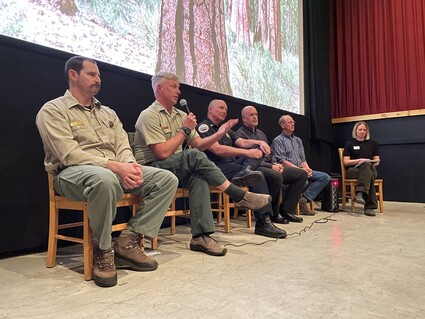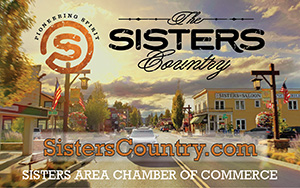Film screening highlights fire danger
Last updated 5/5/2023 at 5pm

Photo by Cody Rheault
A panel of agency officials answer questions after a screening of "The West Is Burning," a documentary exploring catastrophic wildfire.
We know what we need to do but do we have the will to do it? That was the burning question that defined last Thursday's screening of the documentary "The West Is Burning." The hour-long documentary was hosted by Discover Your Forest at the Sisters Movie House, a free event encouraging community members to learn and join in the discussion of wildfire risk and management in the western states.
The documentary tells poignant stories of personal loss with wildfire up and down the Pacific Coast from 2016 to today. The film visits California, Oregon, and Washington as it strives to explain the current wildfire epidemic. Small-town lumber industries battle large-city ecologists in a showdown of right versus wrong for protecting woodlands while understanding the role timber plays in the economy. Throughout the film the delicate dichotomy plays out as lawmakers, environmentalists, and elected officials seek to find the answer to the growing issues of encroaching wildfires on our communities, and common ground to address it.
The documentary lays out the issue of poor land management - and the tinderbox it created - dating back to the early timber years when logging stripped the land of biodiversity and laid the foundation for a new wildfire ecology that burns hotter and faster than ever before. Previous fires were prevalent - large but relatively less intense while naturally enriching soils. But today over 80 million acres, roughly the size of the state of California, within the western United States is designated high-risk territory for a major wildfire event. These new fires burn hotter, leaving behind the eerie charred remains the Sisters community is no stranger to. And the fingers of growing communities reach increasingly into wildfire danger zones.
The film ultimately boils down to a few solutions: manpower, fuels reduction, and collaboration. Fuels reduction is the act of removing fallen trees and smaller timber to provide defensible space, and making fires less intense. That requires manpower, funding, and collaboration between communities and organizations - something Sisters Country has demonstrated.
Post-screening, a discussion panel hosted by Discover Your Forest's Emily Curtis fielded questions related to the film. That panel consisted of Mark Webb, executive director of Blue Mountains Forest Partners in Grant Country, Kevin Moriarty, Deschutes County forester, Roger Johnson, fire chief for the Sisters-Camp Sherman Fire Department, Ian Reid, Sisters District Ranger of the Deschutes National Forest, and Luke Garcia, fuels planner for the Sisters Ranger District.
Reid took an early question regarding fuels management within Sisters Country, and assured the audience that was a top focus to prevent wildfires in the community.
"Fuels is the only thing we humans can influence," Reid said.
He explained that a speedy strategy of maintaining and reducing those fuels is underway, including cooperation in a national fuels reduction initiative where Deschutes County was one of 10 counties in the nation selected for early funding in the 10-year process.
Garcia followed that answer with the District's desire to use all tools available to reduce wildfire risk, assuring that they are aware of the problem and are actively addressing it. They average 2,000 acres of controlled burning per year, with annual mowing, brush management, and pile burning to manage fuels. He says the 2017 Milli and 2020 Green Ridge fires eventually ran into areas that were previously managed, which ultimately helped bring the fire under control.
"There are a lot more homes in harm's way than the harm is getting worse," said Chief Johnson, echoing a line from the film.
He explained that managing and maintaining defensible space zero to five feet away from your home is the bare minimum to give it a fighting chance against a wildfire. Building with smarter, less-flammable materials, and maintaining property free of fuels is the best way to insure homes in Sisters will last, he said.
The issue of manpower and funding harkens back to the solution found in collaboration. And it's a solution Sisters Country has in its back pocket. All panel members reinforced the idea of a community focus on solving the problem and working together to find those solutions.
"We need to work together to make our community resilient," said Johnson.
Project Wildfire, Firewise, and Fire Adapted Communities are a few examples in Central Oregon informing communities on how to make that difference. Forest Service funding and resources are limited, but the collaboration of organizations and communities are what make Sisters Country resilient to catastrophic wildfire.
And that's what makes Sisters unique. With three fire departments, a Forest Service district office, and an Oregon Department of Forestry office all within the same town on a shared radio frequency, responses to wildfires are swift and cohesive.
"And the value of that can't be overstated," said Johnson. "That's really what makes us different from other counties, and more resilient to wildfires."
(Editor’s note: This story was edited to correct a quote from Sisters District Ranger Ian Reid).
















Reader Comments(0)